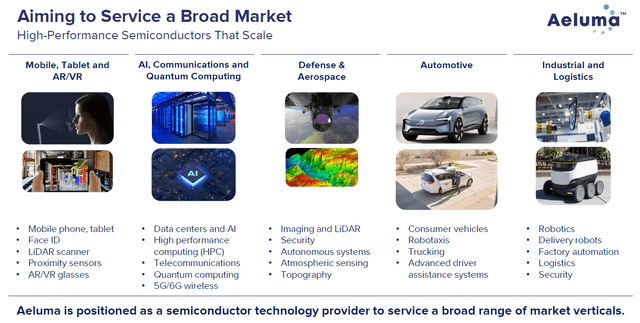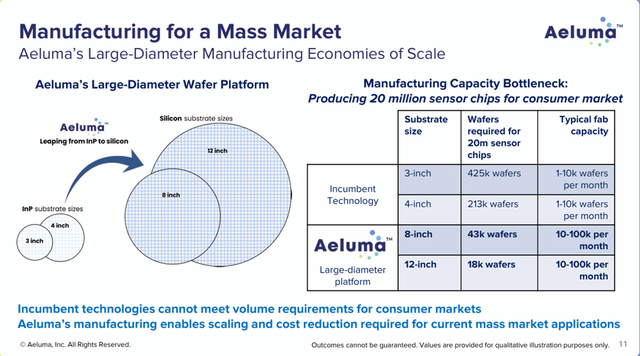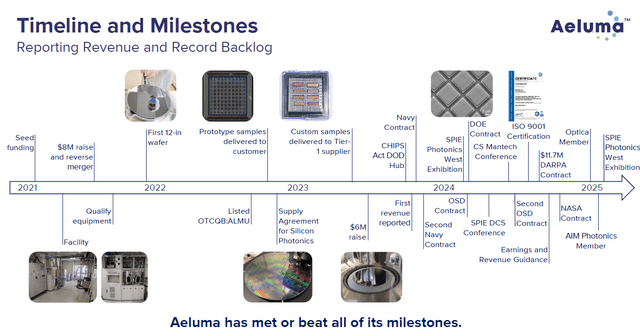Aeluma– A microcap with game-changing potential, so thinks DARPA/NASA?
(Archived article for April 24, 2025)
Summary
ALMU is a rapidly growing semiconductor company that addresses multiple high-growth industries with leading-edge technology.
DARPA has already been awarded a nearly $12M non-dilutive contract for future advanced-node semiconductor development.
The company was recently uplisted to the Nasdaq in conjunction with a $12 million offering to institutional investors through Craig-Hallum.
With a robust patent portfolio, revenue, grants, and general progress ALMU has made during the past four years, the company and stock only lack investor awareness.
ALMU may be on the verge of many new customers and positive announcements. This week, they announced a new contract with the Department of Energy for Scalable Semiconductor Sensors.
Aeluma (NASDAQ:ALMU) is a microcap (with a market cap of ~$110 M) seeking to drastically reduce the cost of producing compound semiconductor materials on 12-inch silicon. Typically, these types of chips (InGaAs-based LiDAR, for example) have only been produced on smaller wafers, which cost about 10X more than Aeluma’s solution. Their technology has applications in Automotive, AI computing, defense, robotics, tablets and phones, and quantum computing.
I believe Aeluma is an interesting speculative microcap investment because:
The technology appears to be game-changing, with a wide and growing range of applicability.
Credible Team: including a Nobel Prize-winning advisor and a former Nvidia exec on the board.
Grants from DARPA, NASA, DOE, the Navy, and the Office of the Secretary of Defense, as well as current commercial discussions.
The market cap seems far too small relative to the opportunity. The recent Nasdaq uplist and possible inclusion in the Russell 2000 are potential catalysts for transitioning Aeluma from “under the radar” to “in the spotlight.”
What Does Aeluma Do?
Aeluma’s potential “game-changer” is the ability to produce high-performance compound devices and chips on conventional 12-inch silicon at a fraction of the current cost (a factor of 10x reduction). This approach is not only cheaper but also more scalable than the current method, which relies on growing these chips on smaller wafers.
These chips take the form of InGaAs LiDAR sensors as well as quantum dot laser photonics. The former is a superior type of LiDAR sensor that can work in a broader range of non-visible light, which is not damaging to the retina. It therefore allows for much stronger illumination than conventional solutions. i.e., your phone could see not only your face in the dark, but also completely map the room. In the laser photonics space, the advantage of Aeluma’s solution is that data could be transferred far more efficiently than current solutions, thus reducing power consumption at a time when one of the most significant challenges in AI is generating enough power to support the necessary infrastructure. Making these types of chips cheaper and in a scalable way holds promise to not only take market share in a growing market but to also create demand with completely new technologies as well as participation by those markets previously priced out.
Below is a slide from an Aeluma presentation given in March 2025 showing which markets they aim to serve:
Here is a slide from the same presentation showing the scale advantages of large-diameter silicon manufacturing.
Momentum: A credible team and several impressive grants
Like many investors, including myself, you may not be an expert in advanced microchip manufacturing techniques, high-performing LiDAR sensors, and quantum dot laser photonics. However, I believe there are strong clues to the technical validation offered by the individuals involved, as well as the steady flow of grants. Namely, Aeluma has received multiple grants from DARPA, DOE, the Navy, NASA, and the Office of the Secretary of Defense. Furthermore, Mike Byron, a former Nvidia executive, has joined the board. The CEO, Jonathan Klamkin, is a professor of Electrical and Computer Engineering at the University of California, Santa Barbara (UCSB), where he earned the NASA Young Faculty Award, the DARPA Young Faculty Award, and the DARPA Director’s Fellowship. In addition, the company benefits from the involvement of Nobel Prize winner Shuji Nakamura as a seed investor, alongside Richard Ogawa, a distinguished patent attorney, serving as both an advisor and seed investor.
I believe that if those groups and people are paying attention, maybe I should too.
Why Now?
In short, momentum. Until now, this company has sailed under the radar. However, the company just uplisted to Nasdaq near the end of last month, and I believe that they could be included in the Russell 2000 on the next rebalance announcement. Further, they have had a constant string of grant announcements along their recent timeline, which, I think, is illustrated well in a slide from their March 2025 presentation below:
I believe the story is already compelling, and as more people see the same story as volume and visibility increase—I think they will tend to like it too. In that way—I think more “eyes on it” alone could be a catalyst, all else being equal.
ALMU is flying completely under the radar of both retail and most institutional investors. At just over $100 million, it remains a microcap company following a recent sole-managed uplisting to the Nasdaq by Craig-Hallum, a top-notch investment banking boutique. For Seeking Alpha subscribers, all one needs to do is look at the company's "Followers". As of Tuesday, April 22, 2025, there are only 116 followers of ALMU. (ALMU - Seeking Alpha Page)
Valuation
It is challenging to arrive at a precise valuation, and it may miss the broader point. I find it more useful to consider the asymmetry of its upside. Here, we have a very healthy balance sheet, exciting revenue growth, and a very large immediate opportunity in InGaAs LiDAR sensors, followed by a medium-term opportunity in Laser Photonics. In addition, the company already has a library of 29 issued patents and patents pending. First, as stated in the March 2025 company presentation: Aeluma already has a “record backlog from commercial and government contracts driving revenue growth” which as of the second quarter of fiscal 2025 was 500% year-over-year growth with a forecasted FY 2025 guidance of $4.4-$4.6 million for a Year-over-year growth of over 375%. While the numbers are not huge, any significant revenue at all at this stage seems impressive to me. The company raised $13.8 million in its Nasdaq uplist raise at the end of last month.
The key to achieving a sizeable evaluation will be the commercialization of Aeluma’s process, which they plan to do first in InGaAs LiDAR sensors. While the opportunity for their laser photonics solutions seems just as exciting—perhaps more—in terms of opportunity, the InGaAs LiDAR sensor market seems to be the most immediate opportunity the company is working on. As of March 2025, Aeluma estimates that the SAM will reach $3.6 billion by 2030. In previous calls, Klamkin, the CEO, said that he believes Aeluma can capture approximately $1.8 billion in revenue by 2030 in the InGaAs LiDAR sensors alone. Obviously, the billion-dollar question is whether to discount the CEO’s odds of success in achieving that goal, and if so, by how much? But let’s make it extreme: let's assume ALMU has only a 50% chance of achieving that goal and another 50% chance that the company will go to zero. That is $800 million of probability-adjusted revenue in just InGaAs LiDAR. What kind of multiple would you assign for a company that has $800 million of revenue on just part of their business, utilizing a game-changing tech applicable to the other part of their business? 10x? 20x? 30x revenue? Even a market cap of only 3 times revenue at that stage would have this at 22 times the current price. I would argue that the chances of zero are very low and that the company will achieve a handicapped percentage range with $1.8 billion in revenue within the range of possibilities the company believes it can reach. I would argue that, depending on the level of success of execution, revenue will be around $500 million on the low end and over $2 billion on the high end for LiDAR sensors alone. Even if the company fell well short of its stated achievable goals, the stock would be substantially undervalued at current levels. For young companies, cash flow is critical. While ALMU has contracts and revenue coming in, it is variable and not yet consistent as they are growing rapidly.
However, this is a very well-managed company, and they err on the side of conservatism from my observations in following them for quite a few months now and listening to their calls. With the roughly $3M in cash they already had, the $15M raise from Craig-Hallum (net of commissions) probably left the company with $12-13M in proceeds. If we assume just over $15M in cash and no debt, along with a stated cash burn rate of $200k-$400k monthly, if the company neither raises any new additional funds nor receives any new government grants or customer revenue, they have conservatively four years of cash or more at this point. Unless it makes sense for the company to increase spending to facilitate faster growth, they are on a very solid trajectory with the funds they currently have in place. Thus, ALMU now has a solid balance sheet for a young public company with enormous growth and revenue opportunities.
Conclusion—ALMU has solid finances for a young company and sufficient capital to achieve its goals for the next several years.
Risks to Consider
Early-Stage Risks: Aeluma’s low revenue and high R&D costs mean it may require additional funding, potentially diluting shareholders. Cash burn is a concern for micro-cap firms.
Competition: Established players (e.g., ON Semiconductor, Hamamatsu) and startups (e.g., POET Technologies) compete in optoelectronics and LiDAR. Aeluma must differentiate through cost or performance.
Market Adoption: LiDAR adoption in automotive and consumer markets could face delays due to cost or regulatory hurdles, impacting Aeluma’s growth timeline.
Volatility: As a micro-cap stock, ALMU is subject to significant price fluctuations, requiring investors to tolerate risk.
Conclusion
This is a micro-cap investment that has all the inherent risks, including high volatility and the potential for significant losses. However, I believe it ticks all the boxes in terms of: Team, potential transformative technology, government grants, progress momentum, price and volume momentum, as well as the chance that “more eyes” will be on it due to the Nasdaq uplisting. Put another way --- if DARPA, NASA, DOE, the Navy, and the Office of the Secretary of Defense are paying attention, so should I! This is why I have a position in this company and believe the upside potential far outweighs the potential risks in the current valuation.
Analyst's Disclosure: I/we have a beneficial long position in the shares of ALMU either through stock ownership, options, or other derivatives.
I wrote this article myself, and it expresses my own opinions.





